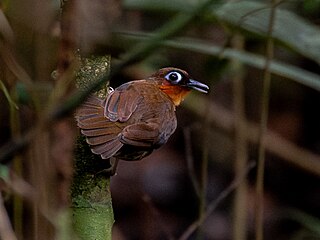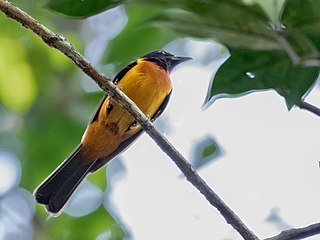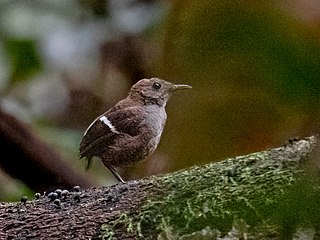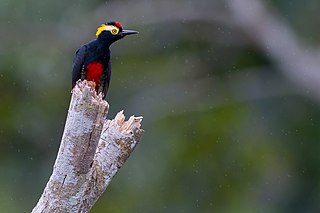
The black-faced antthrush is a species of passerine bird in the family Formicariidae. It is found in Central America from Honduras through Panama, on Trinidad, and in every mainland South American country except Argentina, Chile, Paraguay, and Uruguay.

The southern white-fringed antwren is an insectivorous bird in subfamily Thamnophilinae of family Thamnophilidae, the "typical antbirds". It is found in Brazil, Colombia, French Guiana, Guyana, Suriname, and Venezuela.

The rufescent tiger heron is a species of heron in the family Ardeidae. It is found in wetlands from Central America through much of South America.

The black nunbird is a species of near-passerine bird in the family Bucconidae, the puffbirds, nunlets, and nunbirds. It is found in Brazil, French Guiana, Guyana, Suriname, and Venezuela.

The rufous nightjar is a species of nightjar in the family Caprimulgidae. It is found in Argentina, Bolivia, Brazil, Colombia, Costa Rica, Ecuador, Guyana, Panama, Paraguay, Peru, Saint Lucia, Suriname, Trinidad and Tobago, and Venezuela.

The lilac-tailed parrotlet is a species of bird in subfamily Arinae of the family Psittacidae, the African and New World parrots. It is found in Colombia, French Guiana, Guyana, Suriname, Trinidad, and Venezuela.

The Amazonian barred woodcreeper is a sub-oscine passerine bird in subfamily Dendrocolaptinae of the ovenbird family Furnariidae. It is found in Bolivia, Brazil, Colombia, Ecuador, French Guiana, Guyana, Peru, Suriname, and Venezuela.

The variegated antpitta is a species of bird in the family Grallariidae. It is found in Argentina, Brazil, Colombia, the Guianas, Paraguay, Peru, and Venezuela.

The rufous-throated antbird is a species of bird in subfamily Thamnophilinae of family Thamnophilidae, the "typical antbirds". It is found in Brazil, French Guiana, Guyana, Suriname, and Venezuela.

The fulvous shrike-tanager is a South American bird in the tanager family Thraupidae. It is found in Brazil, Colombia, Ecuador, French Guiana, Guyana, Peru, Suriname, and Venezuela. Its natural habitat is subtropical or tropical moist lowland forests.

The helmeted pygmy tyrant is a species of bird in the family Tyrannidae. It is found in Brazil, Colombia, French Guiana, Guyana, Peru, Suriname, and Venezuela. Its natural habitats are subtropical or tropical moist lowland forests and heavily degraded former forest.

The wing-banded wren is a species of bird in the family Troglodytidae. It is found in Brazil, Ecuador, French Guiana, Guyana, Peru, Suriname, and Venezuela.

The black-throated antbird is a species of passerine bird in subfamily Thamnophilinae of family Thamnophilidae, the "typical antbirds". It is found in Bolivia, Brazil, Colombia, Ecuador, French Guiana, Guyana, Peru, Suriname, and Venezuela.

The wing-banded antbird is a species of passerine bird in subfamily Myrmornithinae of family Thamnophilidae, the "typical antbirds". It is found in Brazil, Colombia, Ecuador, French Guiana, Guyana, Nicaragua, Panama, Peru, Suriname, and Venezuela.

The hooded tanager is a species of bird in the tanager family Thraupidae. It is found in Argentina, Bolivia, Brazil, Colombia, French Guiana, Guyana, Paraguay, Peru, and Venezuela. Its natural habitats are subtropical or tropical moist lowland forest, subtropical or tropical mangrove forest, and heavily degraded former forest.

The red-necked woodpecker is a species of bird in subfamily Picinae of the woodpecker family Picidae. It is found in every mainland South American country except Argentina, Chile, Paraguay, and Uruguay.

The ringed woodpecker is a species of bird in subfamily Picinae of the woodpecker family Picidae. It is found in every mainland South American country except Argentina, Chile, Paraguay, and Uruguay.

The yellow-tufted woodpecker is a species of woodpecker. It is found in Bolivia, Brazil, Colombia, Ecuador, French Guiana, Guyana, Peru, Suriname, and Venezuela. Its natural habitats are subtropical or tropical moist lowland forests and heavily degraded former forest.

Formicarius is a genus of passerine birds in the family Formicariidae. These birds are all found in the tropical New World, from southern Mexico south to Central America and northern South America. All are named as antthrushes, and are insectivorous forest birds. They are largely terrestrial, feeding mainly on the ground on ants and other insects.

The Guianan warbling antbird, or Guianan antwarbler, is an insectivorous bird in subfamily Thamnophilinae of family Thamnophilidae, the "typical antbirds". It is found in Brazil, French Guiana, Guyana, Suriname, and Venezuela.






















